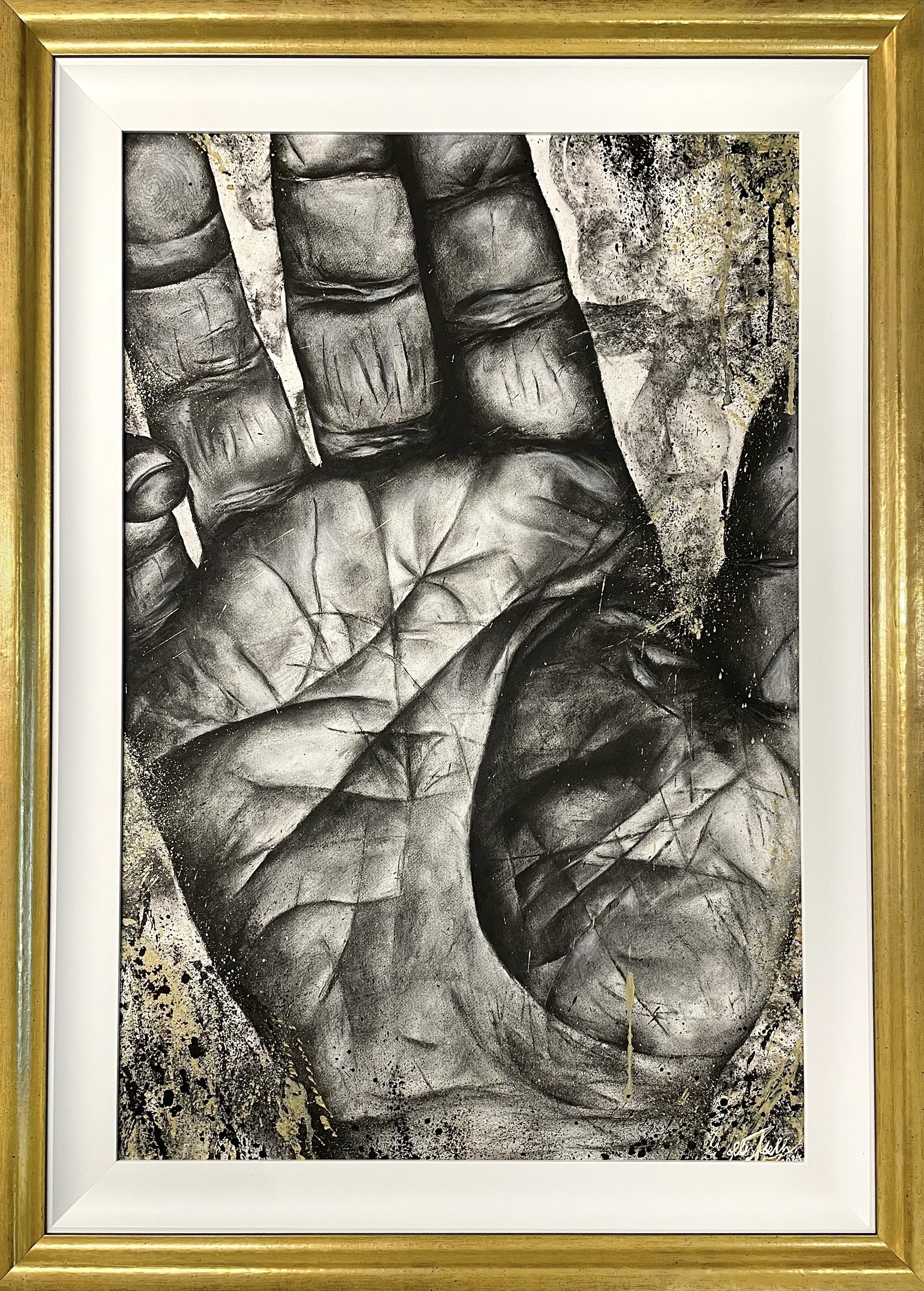Charcoal
Anatomy (2025)
The human hand is a profound testament to our ability to shape and interact with the world. This piece invites viewers to contemplate the intricacy of the human hand not merely as an anatomical organ, but as a map of experience, identity, and resilience. The lines, ridges, and creases etched into the palm are universal in form yet deeply personal in their story, a silent narrative of individuality and a life lived.
Through the interplay of black charcoal, gold, and black ink, the artwork captures both the physical and metaphysical dimensions of the hand. The rich charcoal strokes render the palm with painstaking detail, emphasising the tactile textures of its landscape. Every ridge and indentation tells a story: of labor, care, strength, and, perhaps, struggle. The choice to shape the piece with the artist's own fingers and palms is a deliberate gesture a method of imbuing the artwork with the very essence of touch.
The background of faint charcoal strokes evokes a subtle resemblance to ashes, hinting at the cyclical nature of existence where beginnings and ends blur together in the continuum of life. This motif of ashes, combined with the luminous gold and subtle black ink splatters, adds a layer of symbolism. Gold represents moments of triumph, healing, and joy, while black embodies pain, loss, and hardship. The splatters' randomness reflects the unpredictability of life, and the way viewers interpret the balance between gold and black mirrors the way individuals experience the interplay of strength and healing in their own journeys.
To gaze upon this hand, especially one marked by the passage of time, is to engage in an intimate act of observation. It is to bear witness to resilience, to honor the untold stories that lie within every crease, and to recognise the profound connection between the physical and emotional worlds. This piece is not merely a celebration of anatomical beauty but a meditation on the impermanence of touch and the enduring impact of the marks we leave behind on the world, on others, and within ourselves. The hand, here, is both a map and a mirror. It is also a reminder that even the smallest details in our lives carry profound meaning, and like the fingerprints on a palm, they remain uniquely, irreversibly ours.
By Elizabeth Tay
Charcoal & Ink on Paper | 29” x 38” Framed

Anatomy (2025)
[Gravity] Charcoal and Ink on Canvas 36" ×36" inches (91cm x 91cm) | Capillary action - sometimes called capillary motion, capillary effect, or wicking, is the process of a liquid flowing in a narrow space without the assistance of, or even in opposition to, any external forces like gravity. With this leopard, its body is partially submerged in a body of water which alludes to the idea of its fur wicking water upwards while maintaining a firm ground prowling through the waters. There is beauty, grace and a sense of steadfastness when combining these two concepts; water being of such graceful and placid nature whilst being vigorous and unrestrained at times reflect the temperament of the leopard. The splatters of paint going upwards add to the movement and reinforce the juxtaposition of these ideas.
Birds Eye (Commission)
Majesty (Auction Piece, SINGALA III)
Majesty II (Commission)


![[Gravity]
Charcoal and Ink on Canvas
36" ×36" inches (91cm x 91cm) |
Capillary action - sometimes called capillary motion, capillary effect, or wicking, is the process of a liquid flowing in a narrow space without the assistance of, or even in opp](https://images.squarespace-cdn.com/content/v1/63f68a9269463c3c6fa76d71/b7e2d0b0-3995-42fc-9466-4555c51bf4ce/IMG_5447.jpg)


